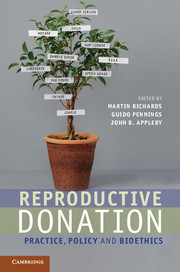Book contents
- Frontmatter
- Contents
- Contributors
- Acknowledgements
- 1 Introduction
- 2 The biology of donation
- 3 Ethics for reproductive donation
- 4 Parenthood – whose right is it anyway?
- 5 Reproductive donation
- 6 UK and US perspectives on the regulation of gamete donation
- 7 Gamete and embryo donation
- 8 The legal and ethical regulation of transnational donation
- 9 Balancing ethical criteria for the recruitment of gamete donors
- 10 Challenges in intra-family donation
- 11 ARTs and the single parent
- 12 Reproductive donation and justice for gay and lesbian couples
- 13 Is disclosure in the best interests of children conceived by donation?
- 14 Identifiable donors and siblings
- 15 Ethical issues in embryo donation
- 16 Reproduction through surrogacy
- 17 Some conclusions regarding the interaction of normative and descriptive elements in reproductive donation
- Index
- References
10 - Challenges in intra-family donation
Published online by Cambridge University Press: 05 August 2012
- Frontmatter
- Contents
- Contributors
- Acknowledgements
- 1 Introduction
- 2 The biology of donation
- 3 Ethics for reproductive donation
- 4 Parenthood – whose right is it anyway?
- 5 Reproductive donation
- 6 UK and US perspectives on the regulation of gamete donation
- 7 Gamete and embryo donation
- 8 The legal and ethical regulation of transnational donation
- 9 Balancing ethical criteria for the recruitment of gamete donors
- 10 Challenges in intra-family donation
- 11 ARTs and the single parent
- 12 Reproductive donation and justice for gay and lesbian couples
- 13 Is disclosure in the best interests of children conceived by donation?
- 14 Identifiable donors and siblings
- 15 Ethical issues in embryo donation
- 16 Reproduction through surrogacy
- 17 Some conclusions regarding the interaction of normative and descriptive elements in reproductive donation
- Index
- References
Summary
Definition and prevalence
Intra-family donation is gamete donation between family members of various degrees of blood or kin relationship. Most intra-family donation involves intra-generational donation between siblings or cousins, most commonly egg donation between sisters or sisters-in-law. Less frequently there is intergenerational donation: usually father to son, daughter to mother or niece to aunt.
There is little data on the prevalence of intra-family donation. Surveys conducted in North America report only the types of intra-family donation that are accepted in the participating centres but provide no information on the number of requests or actual procedures performed (Marshall, 2002; ASRM Ethics Committee Report, 2003). Similarly, the International Committee on Monitoring Assisted Reproductive Technologies (ICMART), which collects data from national IVF registers, does not collect data on specific types of donation. In the early days of IVF egg donors tended to be known. Some US fertility experts advocated sister-to-sister donation rather than anonymous donation (Lessor, 1993). Studies at that time reported positive attitudes towards egg donation by sisters among infertile couples (Sauer, 1988) and the broader public (Lessor, et al., 1990).
- Type
- Chapter
- Information
- Reproductive DonationPractice, Policy and Bioethics, pp. 168 - 188Publisher: Cambridge University PressPrint publication year: 2012
References
- 3
- Cited by



